Haggerston Tenants Reject Imposition of Private Company
Posted: November 7, 2003 Filed under: Gentrification / Regeneration, Haggerston, Privatisation / Sell Offs Comments Off on Haggerston Tenants Reject Imposition of Private CompanyOn 1 November 2003, Pinnacle took over the housing management of St Mary’s Estate in Haggertson. Despite calls for a tenant ballot on the issue, the council undertook a limited consultation exercise, the results of which have not been made public. However, at a meeting in early August, 30 out of 35 people asked for a choice to remain with the council.
Ignoring the results of this consultation meeting, the council’s cabinet decided to press ahead with the transfer of estate management to Pinnacle. It should be noted that the choice tenants were given by the council was between privatisation this year, or possible privatisation next year, ie no real choice at all.
Hackney Independent Working Class Association has spoken to nearly half the tenants on St Mary’s, 160 of whom have signed a petition calling for a tenant ballot on the issue and to be given the choice of remaining with the council. The petition has been sent to Cllr Jamie Carswell, head of Housing at Hackney Council.
As a tenant from St Mary’s states, “The majority of tenants and residents were unhappy that there were only two options on the voting paper and most added a third option stating that they wanted things to remain as they were. These feelings were ignored as was a direct question to Jamie Carswell asking for a ballot”.
IWCA spokesperson Carl Taylor said : “This is not about the rights and wrongs of privatisation – although the IWCA is opposed to it – but the fact that tenants have not been given a real choice or the opportunity to vote on the matter. Consultation New Labour-style is clearly no substitute for genuine democracy.”
A new lease of life
Posted: October 13, 2003 Filed under: Community Facilities, Gentrification / Regeneration, Media Comments Off on A new lease of lifeWith latest figures showing an astonishing increase in the number of empty properties in Hackney (from 795 to 2895 in the space of just a year), we reprint here an article from The Guardian’s website arguing the case for local councils taking over ownership of private properties left vacant for no good reason.
(Friday October 10, 2003 – Society Guardian website)
As consultation ends on a scheme to force landlords to bring their empty properties back into use, Jack Dromey urges the government to take measures to implement it
With all the talk at the moment of a housing crisis, you could be forgiven for not picking up on the fact that there are a startling 729,770 empty homes across England. Not a lot of people know that but just think of the contribution that they could make to meeting housing need?
While some of these empty homes are in areas of low demand for housing, over half are empty where there is high housing need. In London and the south-east, for example, there are just under 185,000 empty homes. Of this total more than 80% are in the private sector and 70,000 have been empty for more than six months.
Yet in 2002 there were around 59,000 families registered as homeless in the same region.
The debate on empty homes in this country has moved on. It is no longer about the shocking management of empty homes by the NHS, Ministry of Defence or local councils, as much work has been undertaken in this area over the last decade. The big challenge now is bringing back into use those long-term empty private homes to meet increasing housing need.
To date local authorities across the land have adopted empty property strategies and have worked with private owners of empty homes to ensure the homes are brought back into use. Through targeted grants programmes, and gaining the associated nomination rights, empty homes have been brought back into use.
Yet a voluntary approach is only sadly going to take us so far. Take just one local authority, the London Borough of Hammersmith and Fulham, which has for many years run a progressive empty property strategy. Despite this excellent work, the council still found itself with over 1,000 properties where their approaches had been turned down. In many cases these owners are “accidental landlords”. They may be owners of a shop, with a flat upstairs, or landlords who have inherited a property. The best long-term solution is to turn these landlords into good landlords or encourage them to make a decision to get out of the property business rather than force them out of it.
An idea was developed with such properties in areas of high housing need, where a good reason can’t be given for keeping the property empty, and the owner has turned down offers of assistance, the local authority should have the discretionary power to take over the management of the property.
The authority would undertake the necessary capital works to make good the house and then the rental income stream could pay for this work. Once the debts had been paid, the management of the house would revert back to the owner. As the management period neared completion, the owner would be offered training on being a landlord or advice on how they could continue letting out the house. The key issue with this idea is that ownership is not the issue it is occupation.
Indeed it can be seen as a win win solution. The owners receive an income and their property is improved, housing need is met and the community loses another empty home and its ability to attract crime and vandalism.
Such a scheme was advocated by the Local Government Association in its submission to the housing and planning select committee and is supported by Shelter, the Royal Institution of Chartered Surveyors and indeed my own union the Transport and General Workers’ Union. And a number of local authorities are expressing interest in this scheme, from Southampton to Salford showing that this idea is not one restricted just to London.
The recent select committee investigation into empty homes in 2002 recommended a pilot scheme to test such a scheme and the government responded with interest to this idea. In their Communities’ Plan published on 5th February 2003, the Office of the Deputy Prime Minister announced that it was minded to go out to public consultation on this issue, and a consultation paper was launched at the joint Empty Homes Agency/Social Market Foundation conference in May.
And we have now come to the end of a three-month public consultation period. The government has responded quickly to the campaign run by the Empty Homes Agency, but it must not lose momentum. Compulsory leasing (or empty homes management orders as the government prefers to call it) has massive potential to increase the supply of affordable housing by using existing assets. This is a radical idea but one that we need to put into action fast.
For that reason I call upon the government to include compulsory leasing in the housing bill when it returns to parliament in the next session. With the current intense pressure for new housing the government must turn this idea from rhetoric to reality soon. We can’t afford to wait.
Jack Dromey is the national convenor at the Transport and General Workers’ Union
For more information on the IWCA’s policies on this issue see www.iwca.info
Dubious Deals on Dawson Street?
Posted: June 16, 2003 Filed under: Community Facilities, Gentrification / Regeneration, Hackney Council, Haggerston Comments Off on Dubious Deals on Dawson Street?16th June 2003
Hackney IWCA has discovered that the destruction of the Victorian former school in Dawson St E2, next to the Hackney Rd Bingo Hall, is nearly complete. Local residents received a letter from Hackney’s Planning Department on Saturday 24 May 2003 informing them that the plans for a 5-storey block of flats were due to be considered at the Planning Committee meeting on Tuesday 27 May. With the Bank Holiday in between this gave residents just one working day’s notice of the meeting, but the letter announced that the Planning Department was to recommend approval of the flats in any case.
This puts to bed another questionable property deal by Hackney Council. The premises were donated to the Borough for community use, and in recent years used by the council’s Social Services department. Last year the entire school building and its grounds was sold – for the criminally low sum of £526,500 according to HM Land Registry (this in a part of Hackney where a tiny terraced house will set you back £300,000!) – to a developer who immediately put forward plans for 22 residential flats and a tiny “D1 community use” area on the ground floor. The development met with concerted opposition from local residents, with 40-odd households objecting to the plans in writing. It’s not hard to do the sums: after selling their 22 flats the new landowner will still clear a million or two comfortably. And it’s not hard to guess who’ll be moving into the flats. Certainly not hard-up tenants from nearby Fellows Court!
Interestingly, the property is now owned by Goodview Ltd who are currently featured on the front of Hackney Labour Party’s website because they want to demolish a pub and build… a block of flats! In that story Labour Party councillors are quoted at length under the headline ‘”Don’t call time on The Vic” say Labour councillors’. Cllr Boyd is quoted as saying, “I am horrified at the proposal to demolish this historic building”. As a local resident has told us “It’s interesting to note the councillors’ sense of priority: they’ll scream and shout and fight to save a pub, but won’t lift a finger to prevent the demolition of a community centre by the same developer. Local people are disgusted by the council’s lack of consultation over this and want to find out how this happened”.
And it would seem Hackney Council aren’t too happy to let people access their records on this sale, claiming that the sale price for the land had been archived and was therefore unavailable. Hackney IWCA and local tenants will be investigating the whole matter further…
Sink or swim in the Basin
Posted: June 15, 2003 Filed under: Gentrification / Regeneration, Media, Olympics Comments Off on Sink or swim in the BasinBelow we reprint an article from The Guardian about regeneration in London. It’s particularly interesting in the light of London’s proposed bid for the Olympics and the push by Labour to get Hackney people supporting it. This article asks the question, do local people benefit from regeneration schemes.
A multi-million pound development is creating 30,000 jobs in a run down area. But, reports Colin Cottell, local people are missing out on the much-needed work
A flagship project with the promise of jobs for the long term unemployed. What could be better for a deprived area of London that sits next to pockets of incredible wealth, but never seems to benefit from the ripple effect?
Occupying a site the size of 60 football pitches three miles west of Oxford Street, Paddington Waterside is a gleaming collection of offices, upmarket homes and holes in the ground that will turn into yet more gleaming offices and upmarket homes. Out goes the seedy prostitution and bedsits image that has dogged the area and in comes shiny 21st century living.
Like east Manchester after the Commonwealth Games, Paddington Waterside is supposed to turn an employment desert into a thriving part of town, creating an extra 30,000 jobs.
Mobile phone company Orange is building its new European headquarters building, the Point, next to one of the canals that run through Paddington. Marks & Spencer is also moving its HQ to the area. Just 11 acres of the site, bought for £85m by a developer, will see £600m spent on it before completion.
Yet on a sunny afternoon last week, two young men kicking a football about on a local council estate, less than half a mile away from the main Paddington site, say they have missed out.
Although in its brief history the regeneration of the area has already spawned several thousand jobs, neither men say that they or residents on the estate have gained anything.
“I don’t know anyone who has found work at Paddington Basin,” says Mark Bradshaw, aged 22. Mr Bradshaw has been in and out of work for the past four years.
“Lots of my mates on the estate are out of work,” he says. What about the construction companies who say they are crying out for people? “They are lying,” he says.
Who to believe? Those who say that urban regeneration projects such as Paddington Waterside bring jobs and prosperity to nearby communities or those who complain that it always the locals who lose out?
One thing is certain, however. More than a decade after Canary Wharf put urban regeneration on the political and social agenda, the question of who gains from massive projects such as Paddington Waterside, and a host of others, including London’s Olympics bid, shows no signs of going away.
Sue Hinds, head of community employment at the London Borough of Tower Hamlets, home to Canary Wharf, says the answer to people who ask if local people are winners is “yes and no”. She adds: “It depends who you talk to. Some employers will think that local people won’t have the skills they need. Some local people will think the jobs are not for them.”
However, in Tower Hamlets as elsewhere the hard facts tell their own story. Employment, including 5,000 construction jobs, may have risen to 60,000 at Canary Wharf, but in its shadow there are around 9,000 residents out of work.
Granted, unemployment has come down, but at around 12% it is still more than twice that of London as a whole, says Ms Hinds, and excludes the large number of people of working age who are economically inactive – including 57% of women.
According to Robert John, an adviser to Canary Wharf, around 7.5% of those employed at Canary Wharf live in Tower Hamlets, up from 4.5% in 1997. But compare the actual number of non-construction jobs held by Tower Hamlets’ residents – around 3,000 in 2001 – with the 150,000 jobs in the borough, and it is clear that there is still along way to go.
The situation has improved as local people’s aspirations have risen, says Mr John. However, more still needs to be done. “We need to work on ways of making places like this not hostile to local people,” he says. “It is not that are there are no jobs, or a lack of opportunities, but poverty of attainment. People have low aspirations. They don’t think they will get those jobs,” says Colin Middleton, program manager at the City Fringe Partnership, which works in deprived areas such as Hackney. However, everyone involved in regeneration agrees that limited aspirations are only part of the problem.
There is a mismatch between the skills employers require and those possessed by local communities, says Mr Middleton. “The skills needed are NVQ Level 4 and above. The majority will have NVQ Level 2 or below.”
Mike Noakes, general manager for BAA Rail, which operates the Heathrow Express at Paddington station, admits: “We do have to look further afield sometimes. High customer service type skills are required for frontline positions such as drivers and staff who work on the trains, and sometimes these are the ones local people don’t have.
“Some of these jobs have been filled by locals, but not so many up to date,” he says. Jobs such as baggage handlers have been easier to fill locally, he adds.
For other employers the only criterion is ability to do the job. “We don’t see it as whether someone is an insider or an outsider, but will they make a decent lawyer or not? The postcode is absolutely irrelevant. We wouldn’t employ someone just because they lived on the Isle of Dogs,” said Iain Rodger, Head of PR at legal firm, Allen &Overy, who employ 200 staff at Canary Wharf.
Nigel Hugill, chairman of Paddington Waterside Partnership, the private sector lead consortium redeveloping Paddington, says that as unemployment has fallen the task of getting the remaining jobless into work has become more difficult.
Kay Buxton, the Partnership’s chief executive, says they have made progress in helping local people to compete.
Since 1999, Paddington First, their non-fee jobs agency has helped find work for over 2,500 people. “Some 40%-50% of people getting jobs through Paddington First live within two miles of Paddington Waterside, and 60% live within [the public transport] zones one or two,” she says.
Employers involved in the Paddington development are doing their bit. All the main contractors and sub-contractors have agreed to advertise their vacancies with Paddington First.
It was generally easy to recruit local people, says Trevor George, construction manager for Wates Construction, who following a customised training course took on three of the 12 trainees employed. Mr George says that the experience left him “pleasantly surprised.”
However, according to John Hodson, director of programmes at Renaisi, a not-for-profit organisation specialising in regeneration, the beneficial effects of large scale construction projects on local employment are often limited. “The contracts are tendered out to major companies and a small proportion will go to local residents,” he says. And even where companies set up training programs, the numbers involved will be “a small proportion of the total workforce”, maybe 20% on a major construction site.
Higher up, the situation is even worse, says Caroline Masundire, managing director of regeneration recruitment consultants Chase Moulande. Despite a severe shortage of planners and surveyors, she has never known a local person get one of these jobs. “It’s men in suits – people who move in for two years and then bugger off.” At least that’s what communities think, she adds.
Even where locals do find work it may be short-lived, says Ms Hinds. “The anecdotal evidence is that people are not staying in their jobs. Most of the unemployed have been out of work for between four months and a year. People get jobs, then go back to being unemployed.” Other anecdotal evidence shows that when local people get well-paid decent work they move out of the area to “somewhere a bit greener,” she suggests.
Figures from Canary Wharf back this up. “Between 1997 and 2001, 640 people moved out of Tower Hamlets after starting work at Canary Wharf,” says Mr John. Those people who move in, by contrast, tend to be “at the top of the deprivation ladder,” says Mr Middleton. “So it starts again – a vicious circle.”
Professor Andrew Church, from the geography department at the University of Sussex, adds: “The community changes as the development occurs.” And because new groups moving into an area may not have the skills necessary to take up the available jobs local unemployment remains high.
Ms Hinds accepts that consistently shifting populations are a reality of inner city life and that this makes it difficult to reduce unemployment for good.
Nevertheless, she remains optimistic. “I think it is changing slowly. But it is changing,” she says.
Whether such change ultimately leads to local people getting their fair share of jobs remains to be seen.
More "Social Cleansing" for Hoxton
Posted: May 16, 2003 Filed under: Gentrification / Regeneration, Shoreditch Comments Off on More "Social Cleansing" for HoxtonThe old cinema on Pitfield Street, Hoxton is next in line to be redeveloped into exclusive flats. It’s part of the process that has been driving local, working class families out of the area and importing new “yuppie settlers”. The IWCA has long opposed this trend in the borough and elsewhere, arguing that the needs of the working class majority should take precedence over those of the moneyed newcomers. But with more and more of our local resources being sold off and buildings such as Laburnum School, Haggerston Pool and many other schools and nurseries under threat, where will it all end?
Below: flyposter making local peoples’ views clear:
"This used to be our library"
Posted: May 16, 2003 Filed under: Community Facilities, Gentrification / Regeneration, Haggerston Comments Off on "This used to be our library"“This used to be our library” – graffiti on a new development off Whiston Rd.
Before becoming a nursery for hospital staff, the new yuppie development was a local library.
Education, Education, Education?
Posted: March 6, 2003 Filed under: Gentrification / Regeneration, Schools Comments Off on Education, Education, Education?
Space to Breathe?
Posted: September 22, 2002 Filed under: Gentrification / Regeneration, Hackney Council, Labour Party Comments Off on Space to Breathe?Photo of the green on Acton estate. This is the only open space on the estate.
Hackney Council had plans to sell it to developers to build houses on it.
Before the election Labour Councillor David Young won a lot of support by getting the site taken off the Council’s disposal list.
Now that the election is safely out of the way, and there is not another one due for four years? The land is back on the disposal list.
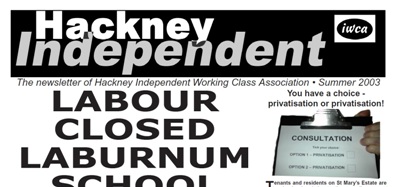
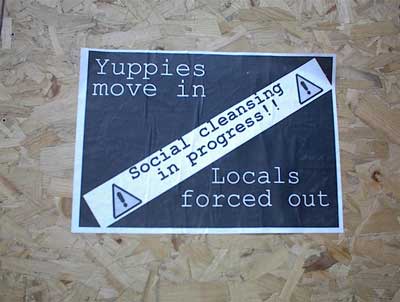
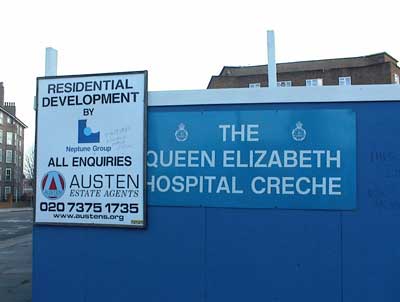
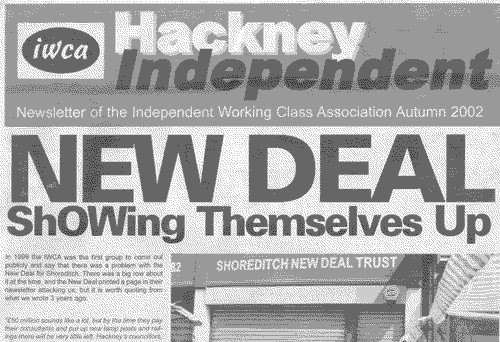
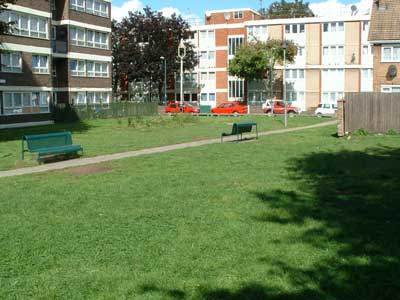
Recent Comments